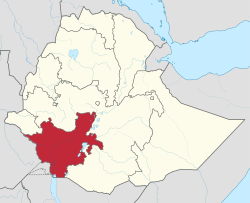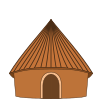Southern Nations, Nationalities, and Peoples' Region
This article needs to beupdated.The reason given is: Succeeded by Central Ethiopia Regional State and South Ethiopia Regional State. Zones and districts have been re-organized.(September 2023) |
TheSouthern Nations, Nationalities, and Peoples' Region(often abbreviated asSNNPR;Amharic:የደቡብ ብሔር ብሔረሰቦችና ሕዝቦች ክልል,romanized:Yädäbub Bḥer Bḥeräsäbočna Hzboč Kllə) was aregional statein southwesternEthiopia.It was formed from the merger of fivekililoch,called Regions 7 to 11, following the regional council elections on 21 June 1992.[1]Its government was based inHawassa.
Southern Nations, Nationalities, and Peoples' Region
የደቡብ ብሔር ብሔረሰቦችና ሕዝቦች ክልል | |
|---|---|
Formerregional state | |
 Map ofEthiopiashowing Southern Nations, Nationalities, and People's Region (1992 to 2020 boundaries) | |
| Coordinates:6°30′N37°06′E/ 6.5°N 37.1°E | |
| Country | |
| Administrative headquarters | Hawassa |
| ISO 3166 code | ET-SN |
The SNNPR borderedKenyato the south (including a small part ofLake Turkana), theIlemi Triangle(a region claimed by Kenya andSouth Sudan) to the southwest, Oromia region to the north and east. The capital city of the region wasHawassa.The region included major cities and towns likeWolaita Sodo,Arba Minch,Jinka,Dila,Boditi,Areka,Butajira,Welkite,Bonga,HosaenaandWorabe.
The region dissolved whenSidama Region,Southwest Ethiopia Region,South Ethiopia Regional StateandCentral Ethiopia Regional Stateemerged independently.
In June 2020, following the formation of theSidama Regionthe region's capitalHawassais located outside of the boundaries of the region. The then regional government planned to move to a city within the region's boundaries after two consecutive national electoral cycles.[2]The largest cities in the region wereSodowith the population of 194,977 andArba Minchwith the population of 151,013.[3]
The dissolution of the region was certain when on 18 August 2023 theSouth Ethiopia Regional Statewas created following the2023 South Ethiopia Region referendumwith remainder of the SNNPR becoming theCentral Ethiopia Regional State.
Demographics
editThis section needs to beupdated.(December 2021) |
Based on the 2007 Census conducted by theCentral Statistical Agencyof Ethiopia (CSA), the SNNPR regional state had an estimated total population of 14,929,548, of whom 7,425,918 were men and 7,503,630 women. 13,433,991 or 89.98% of the population are estimated to be rural inhabitants, while 1,495,557 or 10.02% are urban; this makes the SNNPR Ethiopia's most rural region. With an estimated area of 105,887.18 square kilometers, this region has an estimated density of 141 people per square kilometer. For the entire region 3,110,995 households were counted, which results in an average for the region of 4.8 persons to a household, with urban households having on average 3.9 and rural households 4.9 people.[4]The projected population for 2017 was 19,170,007.[5]
In the previous census, conducted in 1994, the region's population was reported to be 10,377,028 of whom 5,161,787 were men and 5,215,241 were women. At the time of the census, the rural population of the Region accounted for 93.2% of the total population.Semien Omo,Wolayita,andGuragewere the three zones with the highest population. The population is concentrated mostly in eastern, northern and central part of the SNNPR while the western and southern part of the region is sparsely populated.
The SNNPR Water Resources Bureau announced that as of the fiscal year ending in 2006, they had increased the area of the region that had access todrinkable waterto 54% from 10 to 15% 15 years ago.[6]In August 2008, the head of public relations for the Bureau, Abdulkerim Nesru, announced that 94 million birr had been spent to further increase the availability of drinkable water in the region from 58% in the previous year to 63.6%. Priority was given to certain zones, such as Sidama, Welayta and Gurage, as well as theAlaba special woredaand several resettlement areas.[7]
Values for other reported common indicators of thestandard of livingfor the SNNPR as of 2005[update]include the following: 10.7% of the inhabitants fall into the lowest wealth quintile; adult literacy for men is 57% and for women 22.4%; and the Regionalinfant mortality rateis 85 infant deaths per 1,000 live births, which is greater than the nationwide average of 77; at least half of these deaths occurred in the infants' first month of life.[8]
| Year | Pop. | ±% |
|---|---|---|
| 1994 | 10,377,028 | — |
| 2007 | 14,929,548 | +43.9% |
| 2017 | 19,170,007 | +28.4% |
| source:[9] | ||
Religion
edit| Religion | 1994 Census | 2007 Census[4] |
|---|---|---|
| Orthodox Christians | 34.6% | 41.9% |
| Protestants | 21.8% | 38.5% |
| Muslim | 15.2% | 14.1% |
| Roman Catholics | 3% | 3.2% |
| Traditional religions | 26.4% | 2.4% |
| Other religious affiliations | — | 0.5% |
Ethnicities
editThe SNNPR, being an amalgam of the main homelands of numerousethnicities,contains over 45 indigenousethnic groups:
| People | 1994 Census | 2007 Census[4] |
|---|---|---|
| Welayta | 12% | 10.59% |
| Hadiya | - | 7.98% |
| Gurage | 15% | 19.54% |
| Gamo | - | 7% |
| Kafficho | - | 5.44% |
| Silt'e | - | 5.37% |
| Amhara | - | 4.10% |
- All ethnicities in region
The ethnicities native to the SNNPR, with percentages of the population as reported in the 2007 national census and organized by linguistic grouping, include:[4]
- Cushitic:
- Alaba– 1.35%, mostly inAlaba special woreda
- Tembaro– 1.32%, mostly in Tembaro Woreda.
- Arbore– 0.04%
- Daasanach– 0.32%, mostly inDasenech(woreda)
- Dirashe– 0.2%, mostly inDirashe special woreda
- Gawwada– 0.43%, mostly inDirashe special woreda
- Gedeo– 4.9%, mostly inGedeo Zone
- Hadiya– 7.98%, mostly inHadiya Zone
- Kambaata– 3.82%, mostly inKembata Tembaro Zone
- Burji– 0.38%, mostly inBurji special woreda
- Konso– 1.47%, mostly inKonso special woreda
- Libido(or Mareqo) – 0.38%, mostly inMareko(woreda)
- Sidama– 19.38%, mostly in the formerSidama Zone
- Kebena– 1.21% mostly inKebena
- Tsamai– 0.13%, mostly inBena Tsemay(woreda)
- Nilo-Saharan:
- Bodi– 0.04%
- Kichepo
- Kwegu– 0.01%
- Me'en– 1%
- Mursi– 0.05%, mostly inSouth Omo Zone
- Nyangatom– 0.12%, mostly inNyangatom
- Shabo,mostly inKeficho Shekicho Zone
- Shita people
- Suri/Surma– 0.17%, mostly inSurma(woreda)
- Omotic:
- Aari– 1.9%, mostly inBako Gazer(woreda)
- Basketo– 0.52%, mostly inBasketo special woreda
- Bench– 2.34%, mostly inBench Maji Zone
- Chara– 0.08%, mostly inSouth Omo Zone
- Dawro– 3.28%, mostly inDawro Zone
- Dime– < 0.01%
- Dizi– 0.23%, mostly inMaji(woreda)
- Dorze,mostly inChencha(woreda)
- Gamo– 7%, mostly inGamo Gofa Zone
- Goffa– 2.41%, mostly inGamo Gofa Zone
- Hamar– 0.31%, mostly inHamer(woreda)
- Kachama,mostly inArba Minch(woreda)
- Karo– 0.01%
- Kafficho– 5.44%, mostly inKeffa Zone
- Konta– 0.54%, mostly inKonta special woreda
- Koorete– 1.02%, mostly inAmaro special woreda
- Male– 0.59%, mostly inMale(woreda)
- Mello,mostly inMelokoza(woreda)
- Oyda– 0.25%, mostly inOyda(woreda)
- Shakacho– 0.44%, mostly inSheka Zone
- Sheko– 0.24%, mostly inSheko(woreda)
- Welayta– 10.59%, mostly inWolayita Zone
- Yem(Yemse) – 0.5%, mostly inYem special woreda
- Semitic:
- Amhara– 4.10%, widespread
- Gurage– 17.57, mostly inGurage Zone
- Silte– 5.37%, mostly inSilt'e Zone
- Zayse– 0.1%, mostly in theLake Zwayarea
- Zergula
Languages
editThe 2007 census reported that the predominantly spoken mother tongue languages includeSidama(19.59%),Welayta(10.48%),Hadiya(8%),Gurage(7.13%),Gamo(6.9%),Kafa(5.36%) andAmharic(4.10%). Other languages spoken in the State includeKambaata,Melo,Gofa,GedeoandDime;because of the relatively few number of speakers of most of the languages in the region, the working language of the state is Amharic (the most widely spoken language in Ethiopia and formerly the only official language).[4]
The 1994 census reported that the predominantly spoken languages includeSidamo(18%),Gurage(14.72%),Welayta(11.53%),Hadiya(8.53%),Kafa(5.22%), andKambaata(4.35%). Other languages spoken in the State includeGamo,Melo,Gofa,andGedeo.[10]
Amharicis still the working language although most pupils get eight years of primary education in their home language and all secondary and further education is in English.[11]
Agriculture
editThe CSA reported that for 2004–2005 100,338 tons ofcoffeewere produced in the SNNPR, based on inspection records from the Ethiopian Coffee and Tea authority. This represents 44.2% of the total production in Ethiopia.
Farmers in the Region had an estimated total 7,938,490 head of cattle (representing 20.5% of Ethiopia's total cattle), 3,270,200 sheep (18.8%), 2,289,970 goats (17.6%), 298,720 horses (19.7%), 63,460 mules (43.1%), 278,440 asses (11.1%), 6,586,140 poultry of all species (21.3%), and 726,960 beehives (16.7%).[12]
Ensetis a major indigenous local crop in the SNNPR.
List of Chief Administrators
edit- Abate Kisho(SEPDM), 1992–2001[13]
- Hailemariam Desalegn,12 November 2001 – March 2006[13]
- Shiferaw Shigute(SEPDM), March 2006 – July 2013[13][14]
- Dessie Dalke,July 2013 – 2018[14]
- Million Mathiwos,2018 – 2019
- Erstu Yirdaw,31 August 2019 – 18 August 2023
Administrative zones
editThe following table shows administrative zones and special woredas (an administrative subdivision which is similar to anautonomous area) is based on information from 2022; the list of second administrative level bodies maintained by theUnited Nations Geographic Information Working Groupdates from 2002.[15]
Former zones
editSee also
editReferences
edit- ^Lyons, Terrence (1996). "Closing the Transition: The May 1995 Elections in Ethiopia".Journal of Modern African Studies.34(1): 135.doi:10.1017/S0022278X00055233.JSTOR161741.S2CID155079488.
- ^"NEWS: SNNPRS Council approves legal framework which makes Hawassa city accountable to future Sidama Regional State".Addis Standard.2019-10-18.Archivedfrom the original on 2021-06-29.Retrieved2021-06-16.
- ^"Population Projection Towns as of July 2021"(PDF).Ethiopian Statistics Agency.2021.Archived(PDF)from the original on 7 July 2022.Retrieved31 May2022.
- ^abcdeCentral Statistical Agency:The 2007 Population and Housing Census of Ethiopia: Statistical Report for Southern Nations, Nationalities and Peoples' Region; Part I: Population Size and CharacteristicsArchived2017-04-06 at theWayback Machine.July 2010.
- ^Population Projection of Ethiopia for All Regions At Wereda Level from 2014 – 2017.Federal Democratic Republic of Ethiopia Central Statistical Agency.Archivedfrom the original on 6 June 2018.Retrieved4 June2018.
- ^"Potable water expansion works underway with over 60mln birr in SNNP State".Walta Information Center. 28 November 2006. Archived fromthe originalon 7 October 2007.
- ^"SNNP State builds, repairs water facilities with over 94 mln birr".Walta Information Center. Archived fromthe originalon 25 May 2011.Retrieved2 March2009.
- ^Macro International Inc."2008. Ethiopia Atlas of Key Demographic and Health Indicators, 2005." (Calverton: Macro International, 2008)Archived2010-11-05 at theWayback Machine,pp. 2, 3, 10 (accessed 28 January 2009)
- ^"Southern Nations, Nationalities, and Peoples' Region population statistics".Archivedfrom the original on 2018-09-24.Retrieved2019-07-02.
- ^"FDRE States-Basic Information, Southern nations and Nationalities".Archived fromthe originalon 18 June 2008.Retrieved10 May2006.
- ^Kathleen Heugh:Margins, Diversity and Achievement: System-Wide Data and Implementation of Multilingual Education in Ethiopia,p. 48, atGoogle Books.In: Durk Gorter, Victoria Zenotz, Jasone Cenoz (eds.):Minority Languages and Multilingual Education: Bridging the Local and the Global.Springer 2013,ISBN978-94-007-7317-2.
- ^"CSA 2005 National Statistics"(PDF).Tables D.4–D.7. Archived fromthe original(PDF)on 18 November 2008.
- ^abc"Ethiopia Regions".Worldstatesmen.org.Archivedfrom the original on October 4, 2013.RetrievedOctober 1,2013.
- ^ab"Ethiopia: Dessie Dalke Appointed As Chief of South Ethiopia State".AllAfrica.Ethiopian Radio and Television Agency. July 13, 2013.Archivedfrom the original on May 25, 2015.RetrievedOctober 1,2013.
- ^"Names and codes for January 2000, Ethiopia".World Health Organization.Archivedfrom the original on 2009-04-20.Retrieved2020-10-05.The information in the WHO spreadsheet is built on information received 18 September 2002 from the Ethiopian Ministry of Federal Affairs.
External links
edit- Official website
- Map of Southern Nations, Nationalities, and Peoples' Region at UN-OCHA[permanent dead link](PDFfile)
- Map of Southern Nations, Nationalities and Peoples' Region at DPPA of Ethiopia(PDF file)
- Ethiopia's Vanishing Tribesslideshow byLifemagazine

